Israeli agora
| 10 Agorot | |
|---|---|

| |
| Obverse: Date palm tree. Lettring ישראל in Hebrew and اسرائيل in Arabic languages. | Reverse: Denomination and lettering אגורות תשכ״ב in Hebrew. |
| Total 247,874,000 coins minted from 1960 to 1977. | |
History[]
The name agora actually refers to three kinds of currencies that were used in Israel throughout its history. All of them have been subdivisions of the main currency units.
This name was used for the first time in 1960, when the Israeli government decided to change the subdivision of the Israeli lira (a.k.a. Israeli pound) from 1000 prutot to 100 agorot.[1] The name was suggested by the Academy of the Hebrew Language, and was borrowed from the Hebrew Bible:
— I Samuel 2:36
The term "piece of silver" appears in Hebrew as "agorat kessef".
In 1980 the Israeli lira was abolished and replaced by the shekel at a rate of 10 IP per 1 shekel. The new subdivision of the shekel was named agora ẖadaša ("new agora"). There were 100 new agorot in 1 shekel. The high rate of inflation in Israel in the early 1980s forced the Israeli government to change the Israeli currency once again in 1985. The new shekel was introduced at a rate of 1000 S per 1 NS. The name agora was used once again for its subdivision. This time the term "new" was avoided, in order to prevent confusion with the older subdivision (the pre-1980 agora was long since out of circulation). Currently, the term agora refers to the 100th part of the new shekel. There are coins of 10 and 50 agorot, though the 50 agorot coin bears the inscription: "1⁄2 New Shekel".
A coin of 1 agora was in use until April 1, 1991[2] and a coin of 5 agorot was in use until January 1, 2008 when the Bank of Israel decided to cease production. This was due to the costs spent on its production which considerably exceeded the coin's value. Today, when paying in cash, the price must be rounded to the nearest multiple of 10 agorot. When buying several items, the rounding is done for the total sum. There is no rounding when paying with cheques, credit cards or bank orders.
Issues[]
Israeli pound[]
| Image | Value | Technical parameters | Description | Date of | ||||
|---|---|---|---|---|---|---|---|---|
| Diameter (mm) | Mass (g) | Composition | Obverse | Reverse | Issue | Withdrawal | ||

|
1 agora | 20 | 1.03 | aluminium 97%, magnesium 3% | Hordeum, "Israel" in Hebrew and Arabic | Value, date | 01.01.1960 | 22.02.1980 |

|
5 agorot | 17.5 | 2.30 (copper) 0.8 (alum.) | 1960—1975: copper 92%, aluminium 6%, nickel 2% | Three pomegranates, "Israel" in Hebrew and Arabic | |||

|
10 agorot | 21.5 | 4.15 (copper) 1.55 (alum.) | 1960—1977: copper 92%, aluminium 6%, nickel 2% | Palm tree, "Israel" in Hebrew and Arabic | |||

|
25 agorot | 25.5 | 6.5 | copper 92%, aluminium 6%, nickel 2% | Lyre, "Israel" in Hebrew and Arabic | |||

|
I£1/2 | 24.5 | 6.8 | copper 75%, nickel 25% | The state emblem, "Israel" in Hebrew, Arabic and English | 12.09.1963 | 31.03.1984 | |
Old Israeli shekel[]
| Image | Value | Technical parameters | Description | Date of | ||||
|---|---|---|---|---|---|---|---|---|
| Diameter (mm) | Mass (g) | Composition | Obverse | Reverse | Issue | Withdrawal | ||
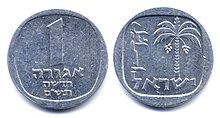
|
1 new agora | 15 | 0.6 | aluminium 97%, magnesium 3% | Palm tree, "Israel" in Hebrew and Arabic | Value, date | 24.02.1980 |
04.09.1986 |
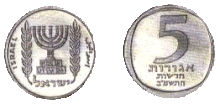
|
5 new agorot | 18.5 | 0.9 | The state emblem, "Israel" in Hebrew, Arabic and English | ||||
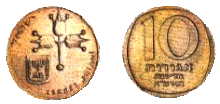
|
10 new agorot | 16 | 2.1 | copper 92%, nickel 8% | Three pomegranates, the state emblem, "Israel" in Hebrew, Arabic and English | |||

|
IS1⁄2 | 20 | 3 | copper 75%, nickel 25% | Lion, the state emblem, "Israel" in Hebrew, Arabic and English | Value, date, two stars | ||
- Note that all dates on Israeli coins are given in the Hebrew calendar and are written in Hebrew numerals.
Israeli new shekel[]
| Image | Value | Technical parameters | Description | Date of | ||||||
|---|---|---|---|---|---|---|---|---|---|---|
| Diameter | Thickness | Mass | Composition | Edge | Obverse | Reverse | Issue | Withdrawal | ||

|
1 agora | 17 mm | 1.2 mm | 2 g | Aluminium bronze 92% copper 6% aluminium 2% nickel |
Plain | Ancient galley, the state emblem, "Israel" in Hebrew, Arabic and English | Value, date | 4 September 1985 | 1 April 1991 |
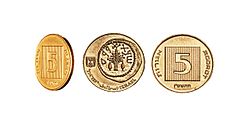
|
5 agorot | 19.5 mm | 1.3 mm | 3 g | Replica of a coin from the fourth year of the war of the Jews against Rome depicting a lulav between two etrogim, the state emblem, "Israel" in Hebrew, Arabic and English | 1 January 2008 | ||||
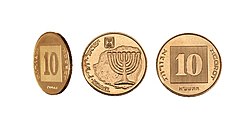
|
10 agorot/
₪1⁄10 |
22 mm | 1.5 mm | 4 g | Replica of a coin issued by Antigonus II Mattathias with the seven-branched candelabrum, the state emblem, "Israel" in Hebrew, Arabic and English | Current | ||||

|
50 agorot/ ₪1⁄2 | 26 mm | 1.6 mm | 6.5 g | Lyre, the state emblem | Value, date, "Israel" in Hebrew, Arabic and English | ||||
- Note that all dates on Israeli coins are given in the Hebrew calendar and are written in Hebrew numerals.
See also[]
References[]
External links[]
- Currencies of Israel